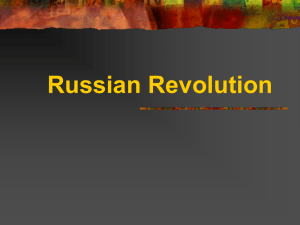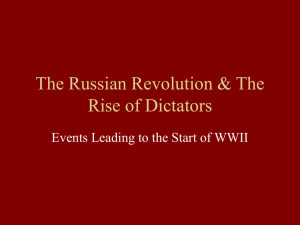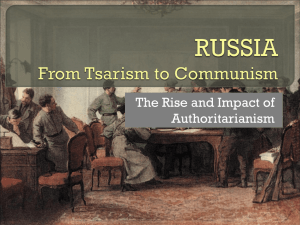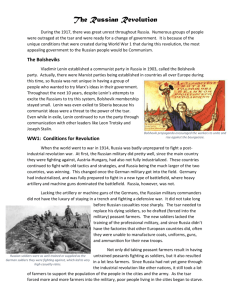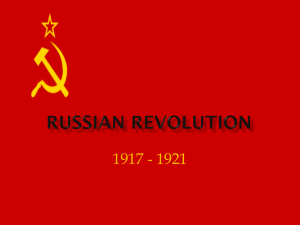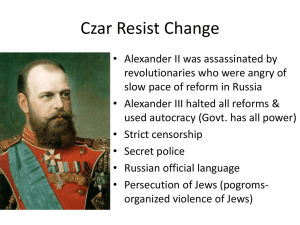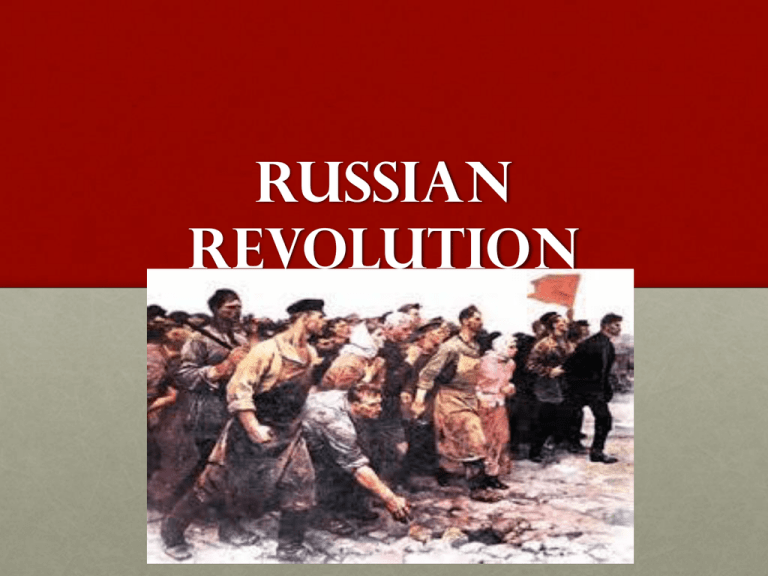
Russian
Revolution
Russian Government
Before Revolution
• Monarchy: The Czar (Tsar)
• Until 1905 the Tsar's powers were unlimited.
• Russia had no constitution,
• no political party system to check the Tsar's power
• A strong secret police which terrorized the people.
Czar Alexander II
• He implemented important reforms, notably the abolition of
serfdom,
• In 1867, he sold Alaska and the Aleutian Islands to the United
States.
• Killed by the Revolutionary Group: “The People’s Will”
• He was killed by the terrorist organization when one of their
members threw a bomb at him while walking the streets of
St. Petersburg
Czar Alexander III
• Alexander III's reign was during an industrial
revolution in Russia .
• His reign was harsh, against revolutionaries and
other liberal movements.
• There was an unsuccessful assassination attempt by
Vladimir Lenin’s brother
Czar Nicholas II (1894)
Last Czar of Russia
Nicholas II was a harsh and weak ruler
The Russian economy was bankrupt because
of the Russo-Japanese War. Russia lost land
and resources
WWI Russia’s entry into WWI became very
unpopular with his people
Queen Alexandria, Son was Alexei (suffered from
hemophilia
Czar Nicholas II and Family
Russo-Japanese War (1904)
Dispute over Manchuria with
Japan
Shook national confidence in their
progress and rule of Czar.
This was an embarrassing loss for
Russia (First victory of an Asian
Russo-Japanese War
(1904)
Bloody Sunday (1905)
This is when Russian citizens protested in front of the Winter
Palace (home of the Tsar) and his military opened fire on the
crowd killing over 100 Russians. This led to Russians having
little trust in their leader. The Tsar was forced to create a
“Duma” to allow representatives a voice
Russia and World War I
• Russia declares war on Austria-Hungary
• War becomes unpopular
• Rationing leads to starvation
• Nicholas II leaves St. Petersburg to war front
• The Tsar is now gone and Queen Alexandria falls under
the spell of Rasputin
Rasputin
Rasputin and his evil
trickery
The Tsar leaves Russia and his wife Queen
Alexandria is in charge
Rasputin’s power comes from the myth that
he is a true healer and upon his touch he can
cure any illness
The Tsar’s son Alexei has hemophilia (blood
clout disease
Rasputin and his evil
trickery
• The Queen falls into his spell because she is convinced
he can heal her son.
• This allowed him to have full control of the royal
family and he put his followers in position of high
government office.
• He is also known as a “Womanizer” he had a certain
flare that attracted a lot of women
• He used Sex as his weapon to take control
• He made horrible decisions and this led to the people
of Russia to question the royal family and saw them as
“Vulnerable”
Assassination of Tsar
Nicolas II and his Family
•The Russian Population was devastated to hear that over 2
million casualties occurred
•Mass desertion (leaving and did not follow orders) made
them feel the Tsar has lost his role as a good leader
•In all over 6 million casualties of war before they quit
•Here is the story of the Assassination
•Show Youtube Re-enactment
•http://www.youtube.com/watch?v=iHsq9Od8bsU
March Revolution (1917)
• 1917- protests spread through St. Petersburg and the
Royal palace is taken over.
• Czar abdicates
• Provisional government (Duma) takes control lead by
Alexander Keresnky
• Provisional government unpopular after decision to stay
in WWI
Vladimir Lenin/October
(Bolshevik) Revolution-1917
• Lead by VI Lenin “Peace, Land, and Bread”
• Won support of people (especially peasants) and he also
related to the factory workers in Moscow and St. Petersburg
• Lenin was sent into exile for his revolutionary actions in
Russia and was sent to Switzerland until 1917
• He was a huge fan of Karl Marx and believed that the rich
capitalist took advantage of the poor
• He believed in Communist thought that stated “government
should have control of production and close the gap between rich
and poor
Vladimir
Lenin/October(Bolshevik)
Revolution-1917
• Vladimir Lenin was a masterful public speaker and his
rallies were explosive.
• He targeted the countryside and Factory courtyards
• Lenin’s Deal with Germany: Germany said they would
pay for Lenin’s travels back to Russia as long as once
he came into power he would leave the war
• The Bolsheviks stormed the “Winter Palace and with
little to no violence the Kerensky government was out
and the Bolsheviks took over
1918
• 1918 March The Bolsheviks accept the peace of Brest-Litovsk,
ending WWI with Germany.
• Here are the Conditions (show this on your Russian Map)
•
•
•
•
Russia must give up the Baltic States to Germany
Russia must recognize Ukraine as an independent country
Russia must give up influence in Finland
Pay six million dollars for raparations
Civil War
Menshevik (White Army)= Russians that were loyal to the Royals and
old ways of Tsarist Russia
They were supported by the United States
Bolshevik (Red Army)=Led by Trotsky (Military Leader) and Vladimir
Lenin
1919 White Armies (Royal and Menshevik troops) attack the Reds
(Bolsheviks) from all directions.
• Bolshevik death count was 125,000/Menshevik was 175,500
• The Cheka (secret police) killed over 250, 000 Russians
• 1920- Reds defeat Whites and this ultimately led to over 7 million
street children
Communism
• A Form of Socialism
• Central Planning of the Economy by the State
• Gov’t (Communist Party) makes decisions on individual
jobs and pay
• Draw the Flag of Communism
•
•
•
•
Red: Bolshevik Party
Hammer: Factory workers/working class
Sickle: Farmers
Yellow Star: Rule of Communist Party


